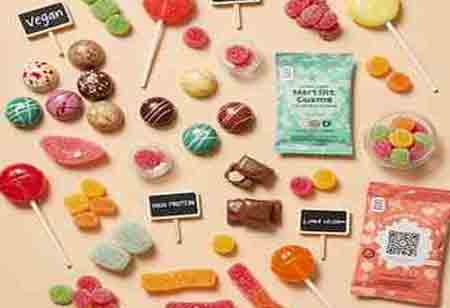Thank you for Subscribing to Food Business Review Weekly Brief
- Home
- Topics
- Alternative Proteins and Plant Based Food
- Beer and Wine
- Canned Beverages
- Coffee And Tea
- Food and Beverage Consulting
- Food and Beverage Financial Service
- Food And Beverages Marketing
- Food Distributors
- Food Ingredients
- Food Sustainability
- Plant Based Food and Beverages
- Seafood Suppliers
- Supplement Manufacturing
- Wine Investment
- News
- Vendor Viewpoint
- CXO Insights
- Conferences
- Newsletter
- CXO Awards
-
Sweet Disruption: The Changing World of Confectionery
Confectionery companies are transforming the industry by embracing health-conscious formulations, sustainable practices, and personalized product innovations.

By
Food Business Review | Tuesday, April 22, 2025
Stay ahead of the industry with exclusive feature stories on the top companies, expert insights and the latest news delivered straight to your inbox. Subscribe today.

Fremont, CA: The confectionery industry continues to evolve as consumer preferences shift, technology advances, and new health-conscious trends emerge. Traditional sweets remain popular, but innovation is excitingly reshaping the market. Confectionery companies respond to changing demands by introducing new ingredients, sustainable practices, and personalized offerings. The latest developments in confectionery reflect a blend of indulgence, health awareness, and environmental responsibility, shaping the future of sweet treats.
Health-Conscious Confectionery
Consumers are increasingly seeking confectionery products to support their health and wellness objectives. Reducing sugar has become a key focus, prompting brands to develop items sweetened with natural alternatives such as stevia, monk fruit, and allulose. Functional confections enriched with vitamins, protein, or probiotics also provide extra nutritional advantages. Dark chocolate, recognized for its antioxidant properties, has become a favored choice for those seeking a healthier treat.
The rise in demand for plant-based sweets has also led to the introduction of dairy-free chocolates and gelatin-free gummies. As consumers become more informed about ingredients, confectionery brands prioritize transparency by clearly labeling nutritional benefits and sourcing details to align with changing consumer expectations.
Sustainable and Ethical Practices
Sustainability has emerged as a significant factor in the confectionery industry, with consumers and manufacturers emphasizing ethical sourcing and environmentally responsible production techniques. The scrutiny of cocoa supply chains has resulted in a rise in fair trade and ethically sourced chocolate. Companies are increasingly adopting eco-friendly packaging solutions, minimizing plastic waste, and utilizing biodegradable materials.
Sustainable palm oil alternatives are being incorporated into products to combat deforestation issues. Some brands are also innovating with upcycled ingredients, transforming surplus food into unique confections while reducing food waste. These initiatives signify a broader industry movement towards responsible consumption, harmonizing enjoyment and flavor with environmental and social responsibility.
Personalization and Distinct Flavor Profiles
The customization trend has gained significant traction in the confectionery sector, providing consumers with tailored experiences through bespoke products. Technological advancements enable brands to craft candies and chocolates with unique flavors, shapes, and packaging options. Limited-edition offerings incorporating exotic and unconventional ingredients appeal to adventurous consumers searching for distinctive tastes.
Fusion flavors, such as chocolate infused with chili or gummies with floral notes, introduce surprising variations to traditional sweets. The emergence of digital platforms allows consumers to create their confectionery masterpieces, choosing ingredients and packaging that reflect their individual preferences. This trend highlights a growing desire for uniqueness as consumers search for products that fit their tastes and identities.
The confectionery industry is experiencing a transformation influenced by changing consumer preferences, ethical considerations, and technological progress. Companies are innovating to cater to the needs of health-conscious consumers, sustainability proponents, and those desiring personalized experiences. As these trends evolve, the confectionery market remains vibrant, merging traditional practices with innovative approaches.






